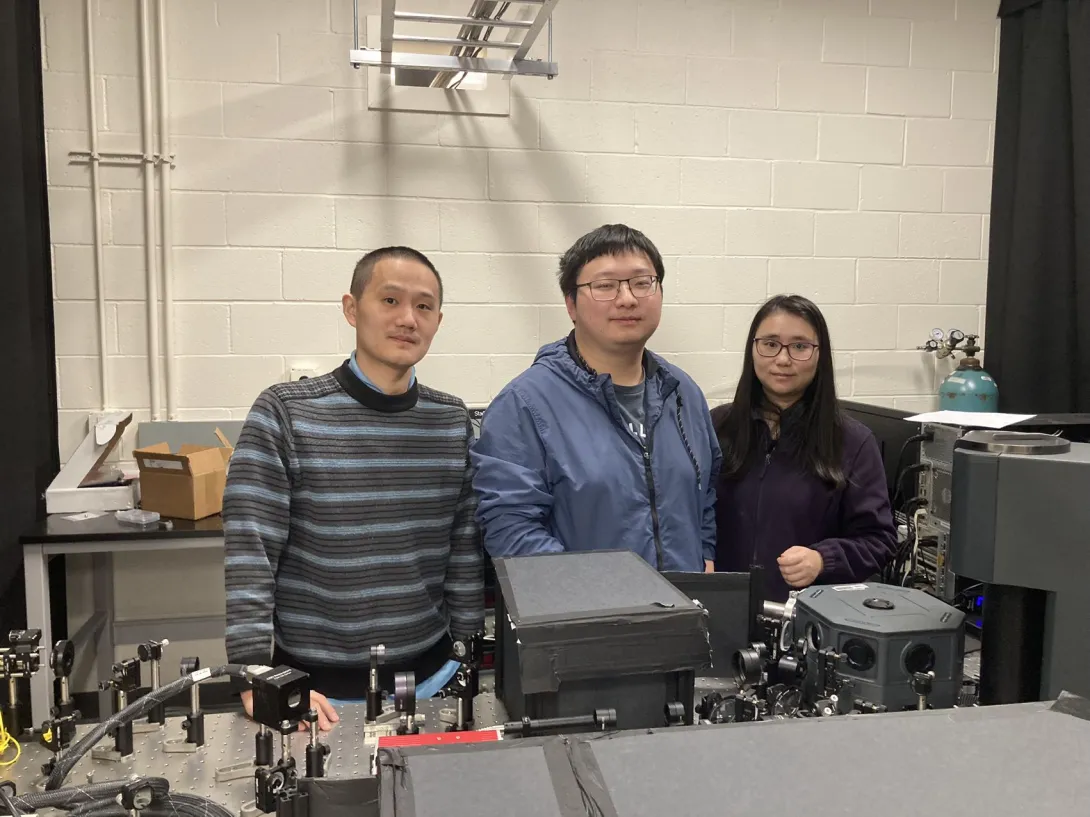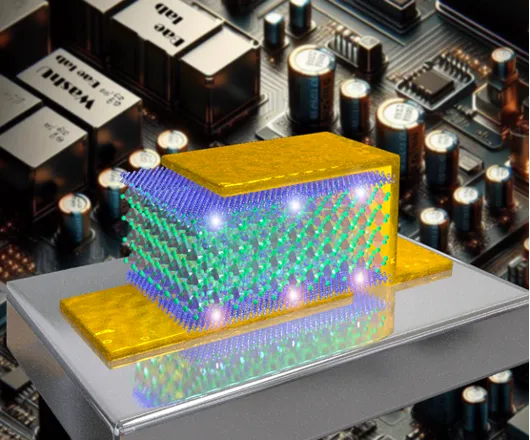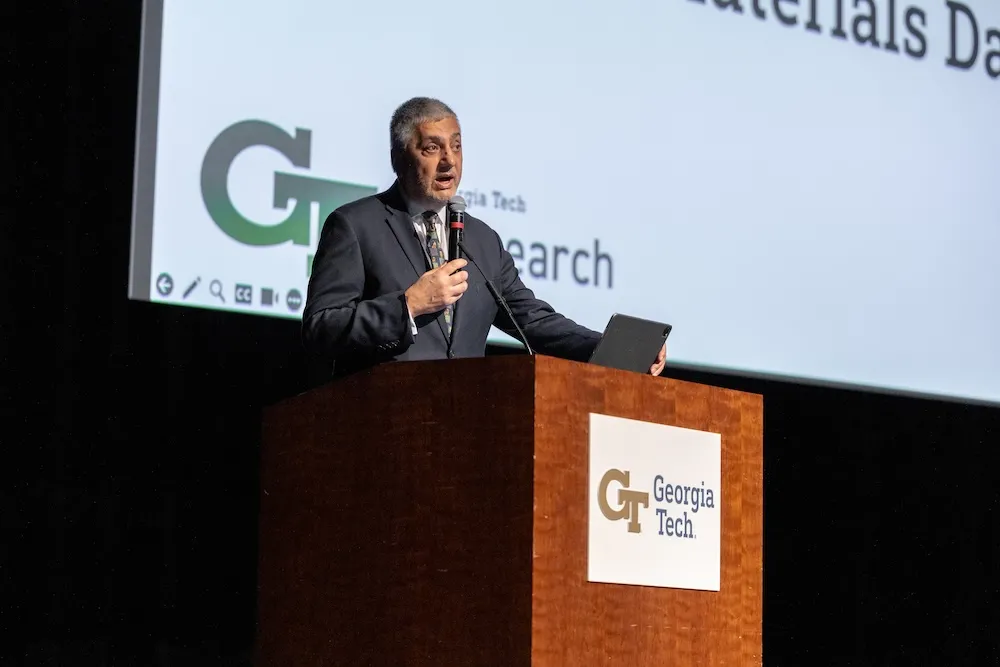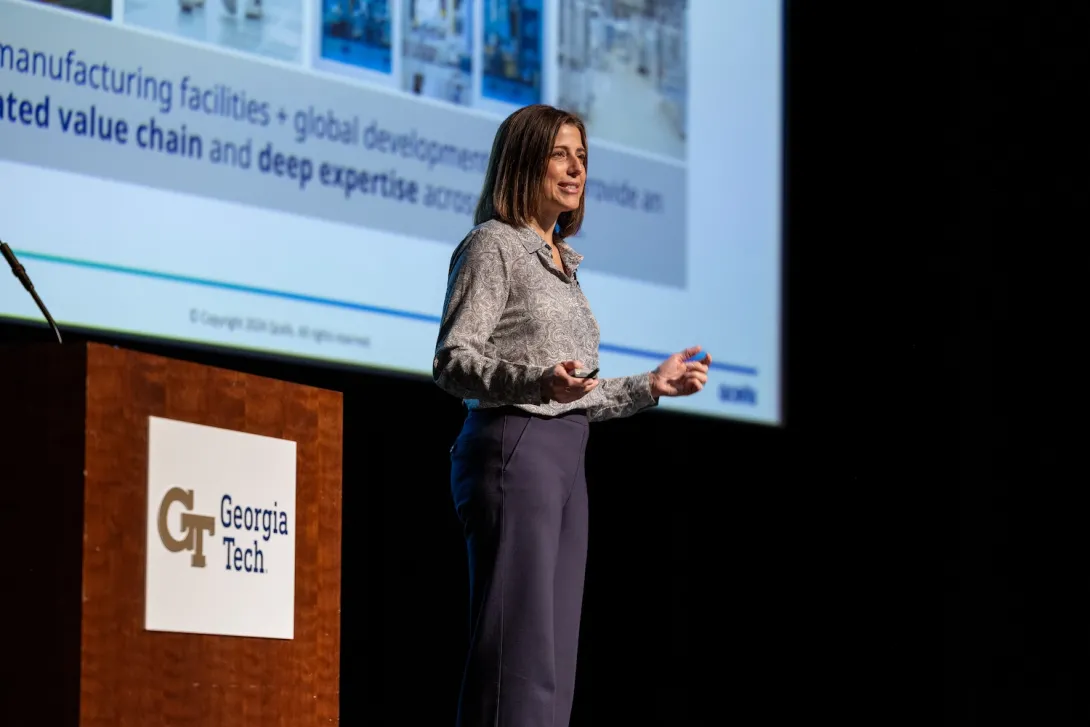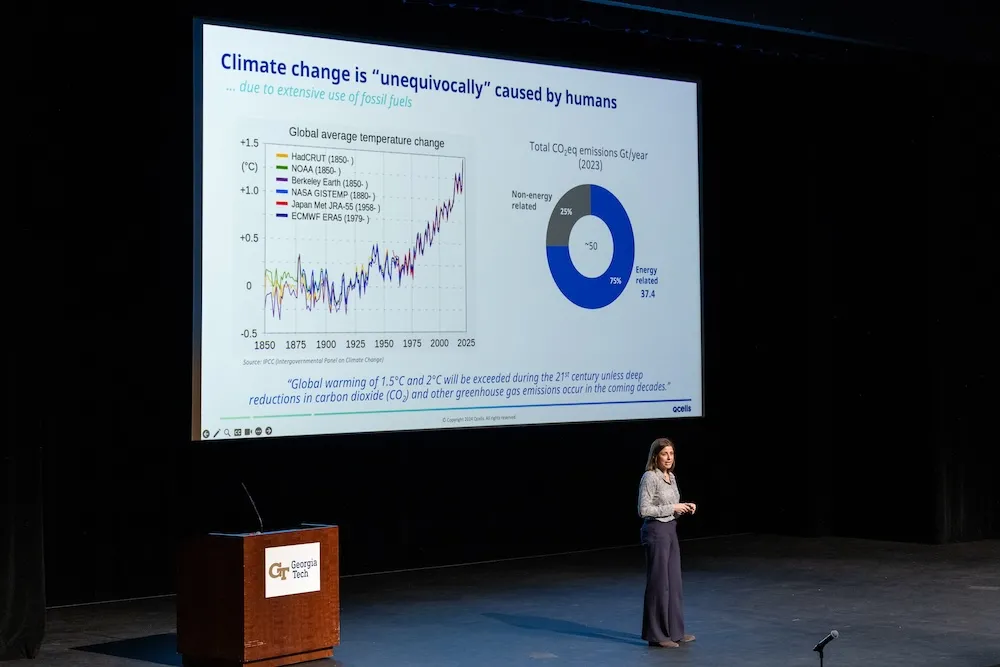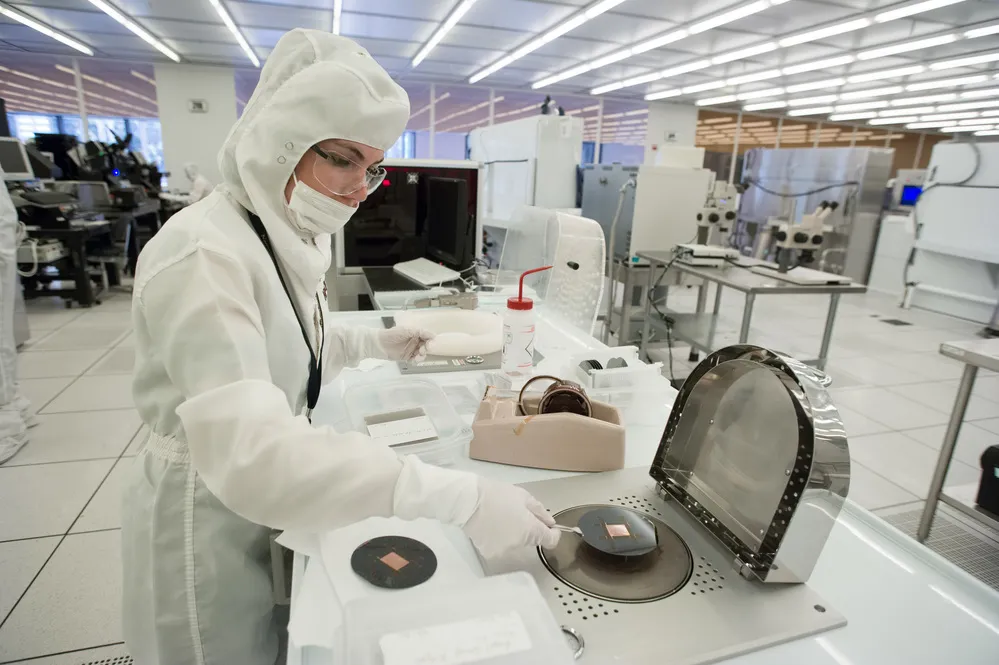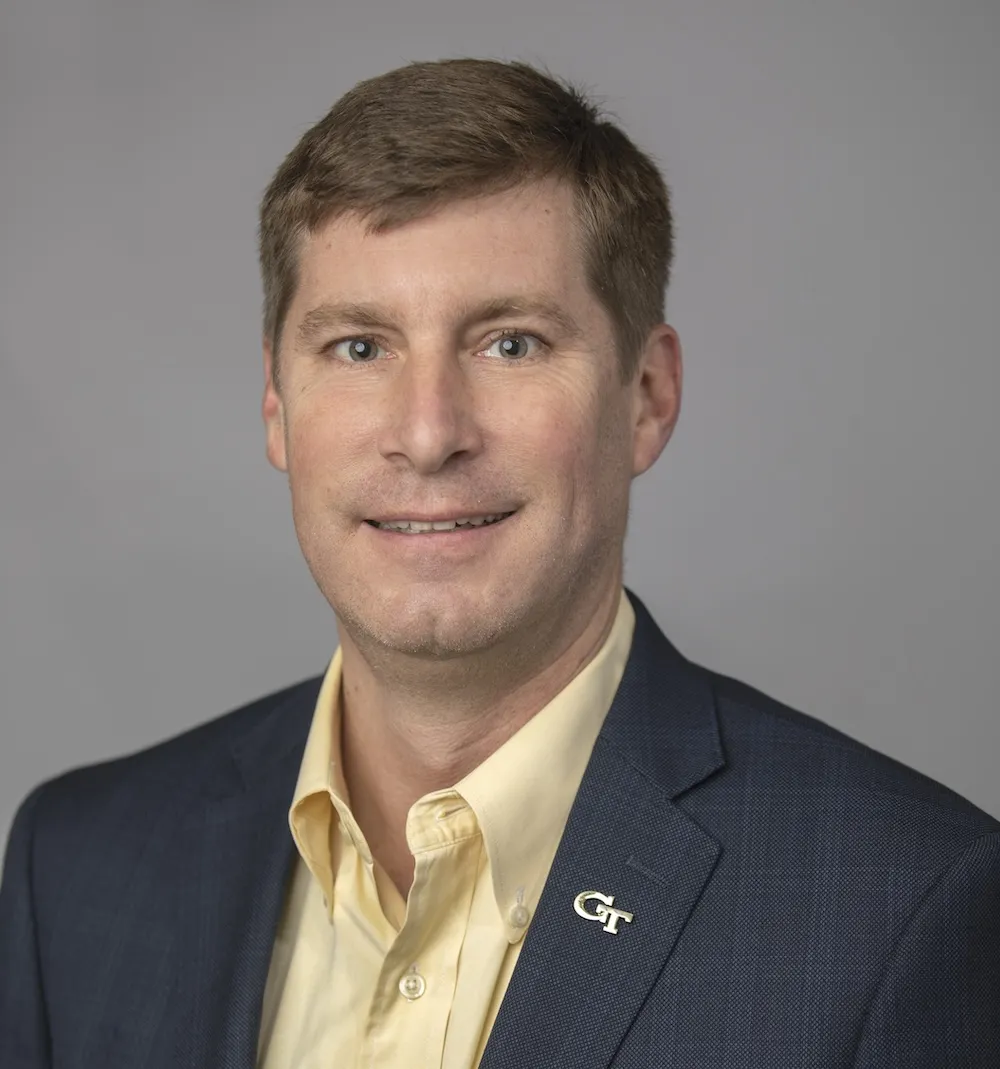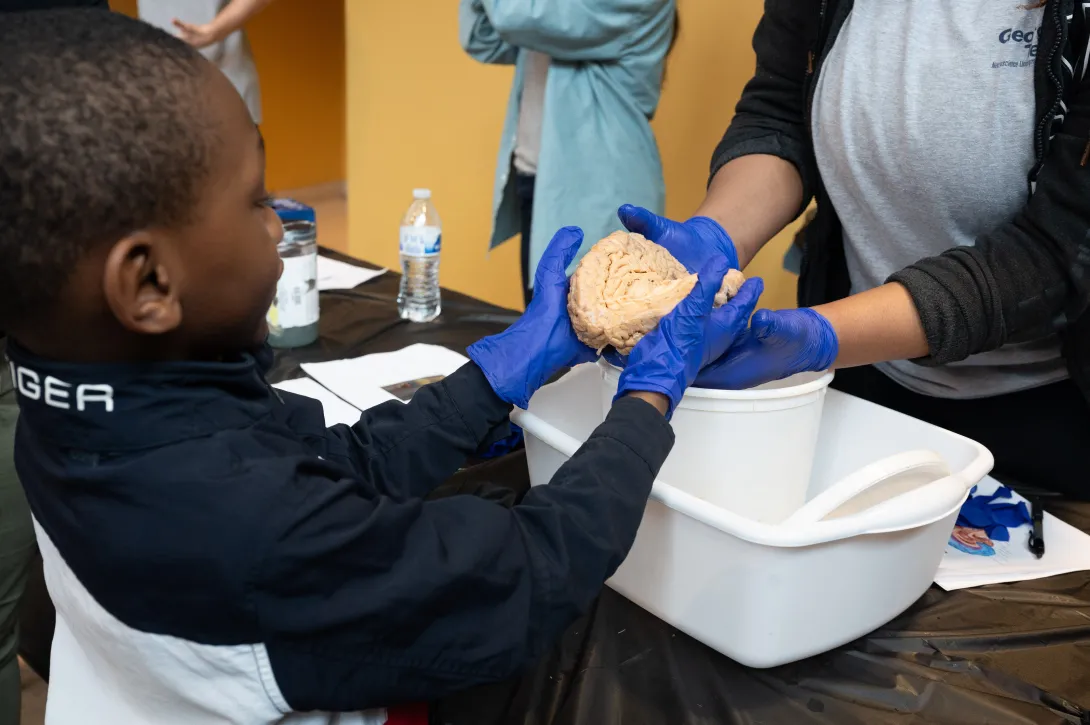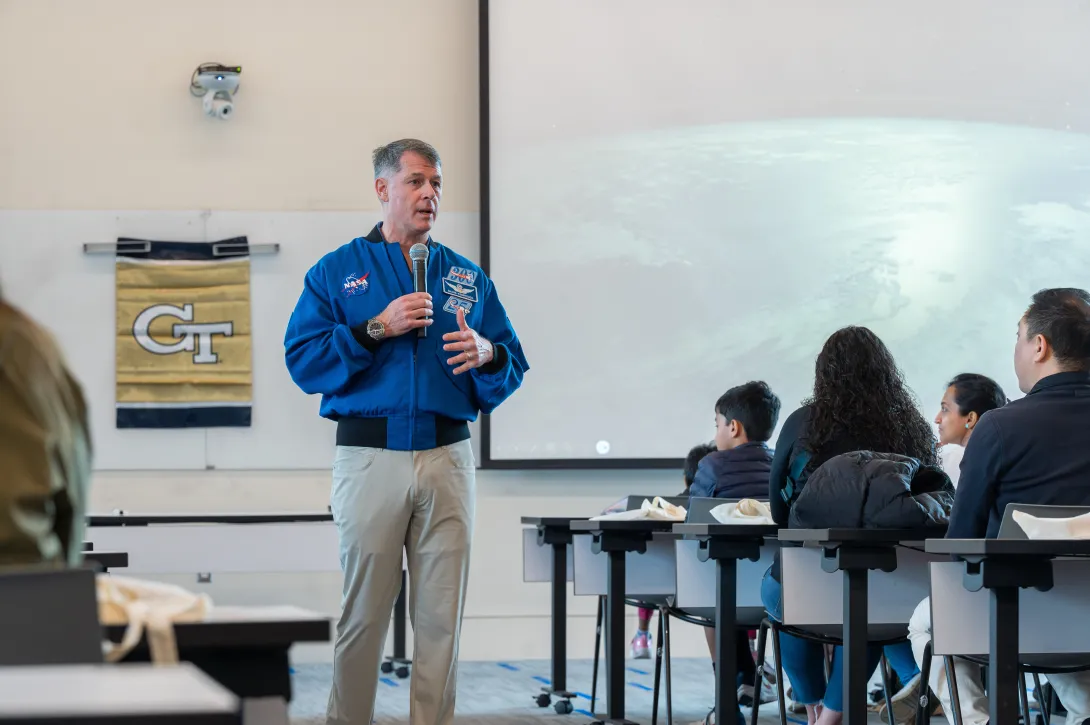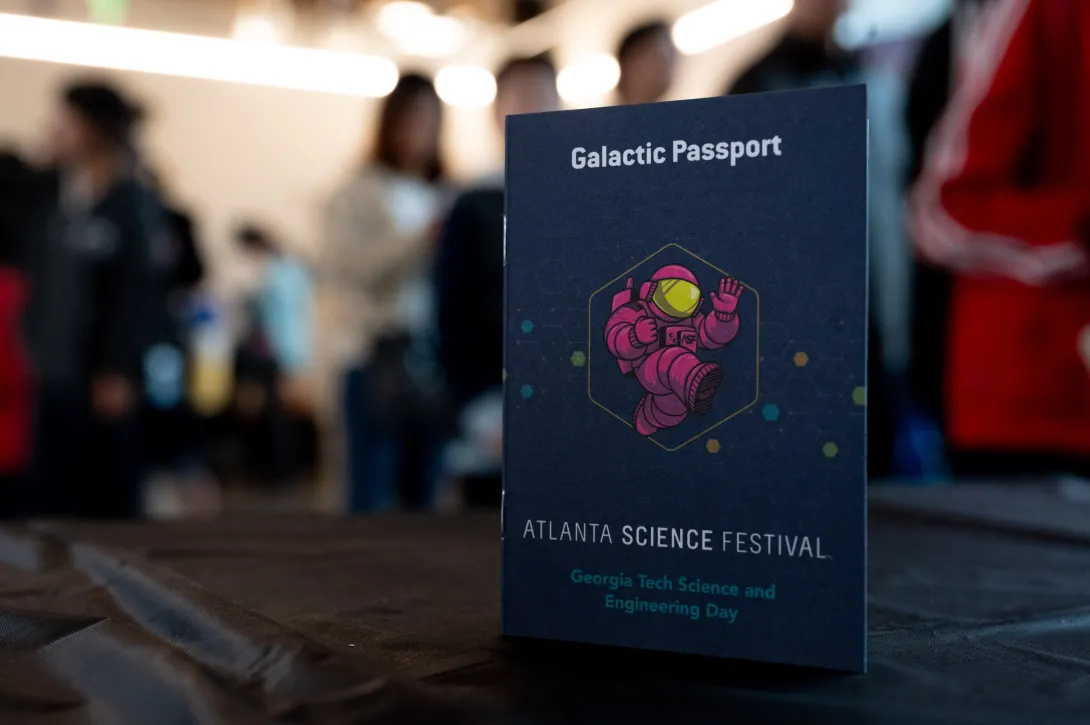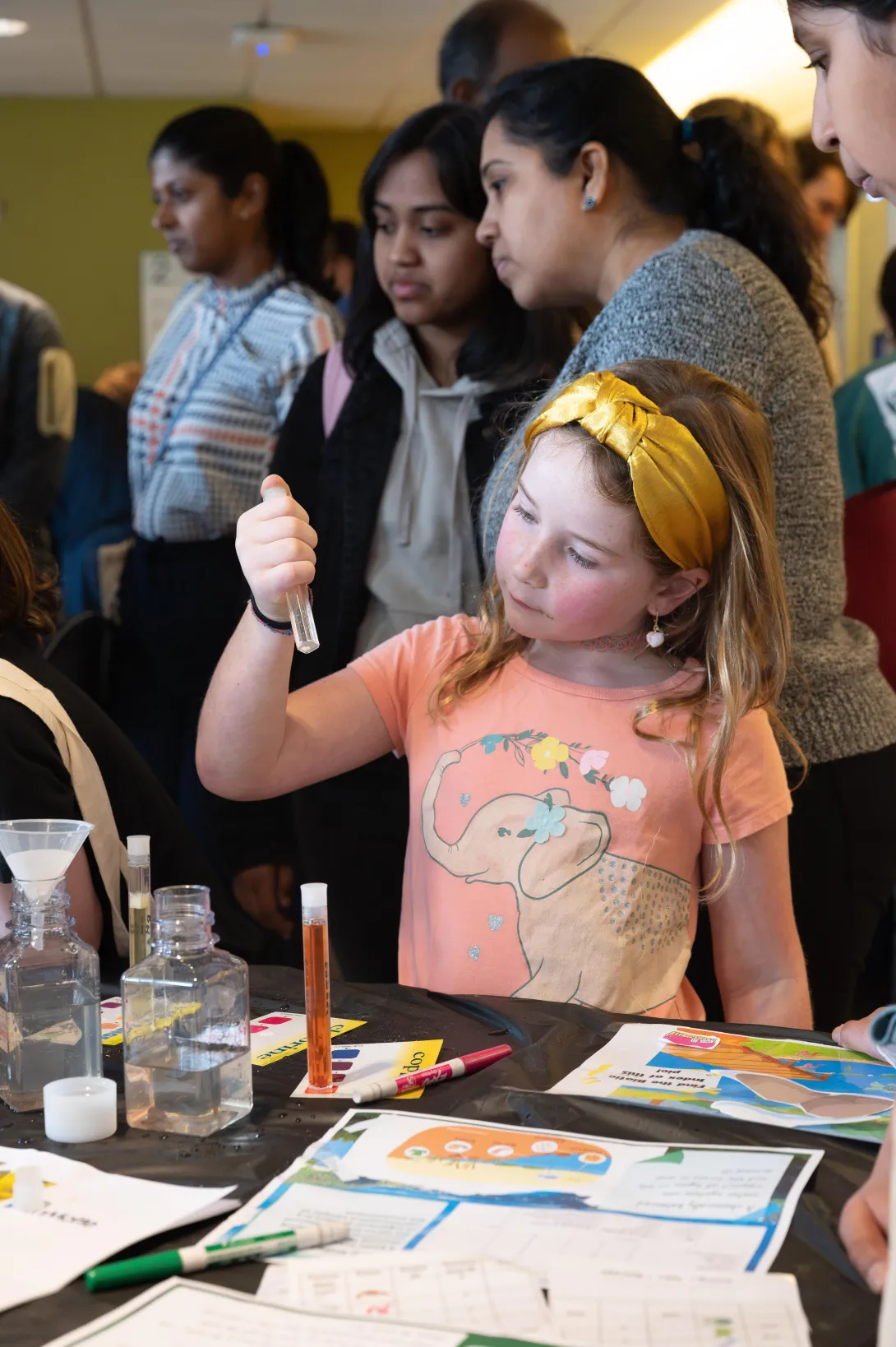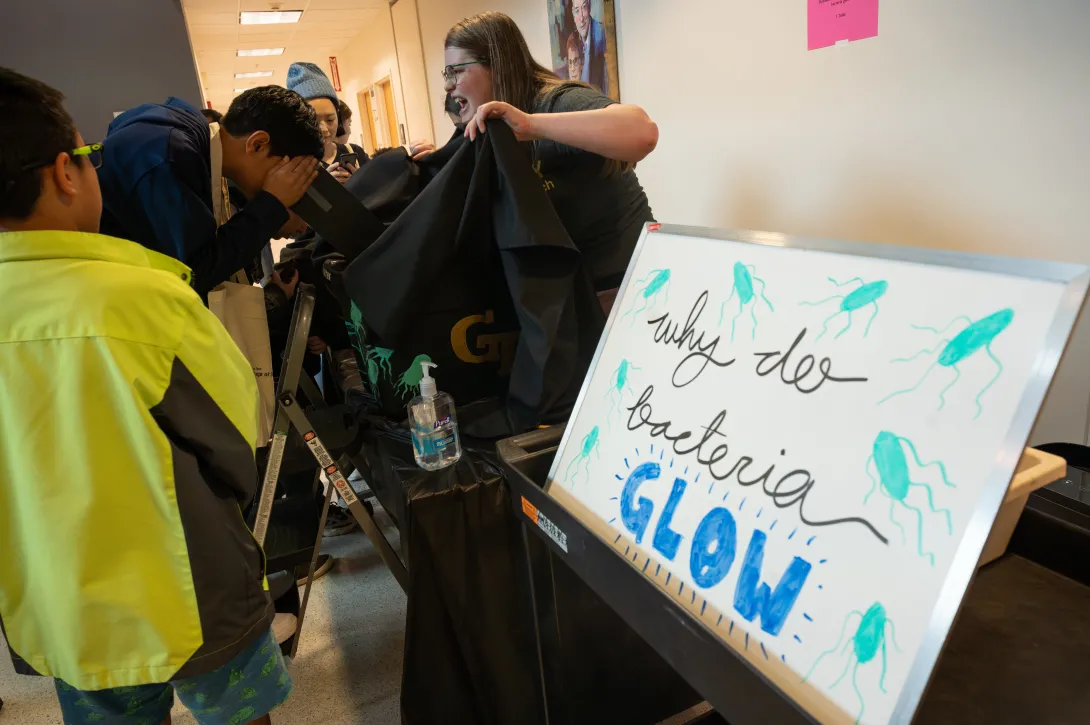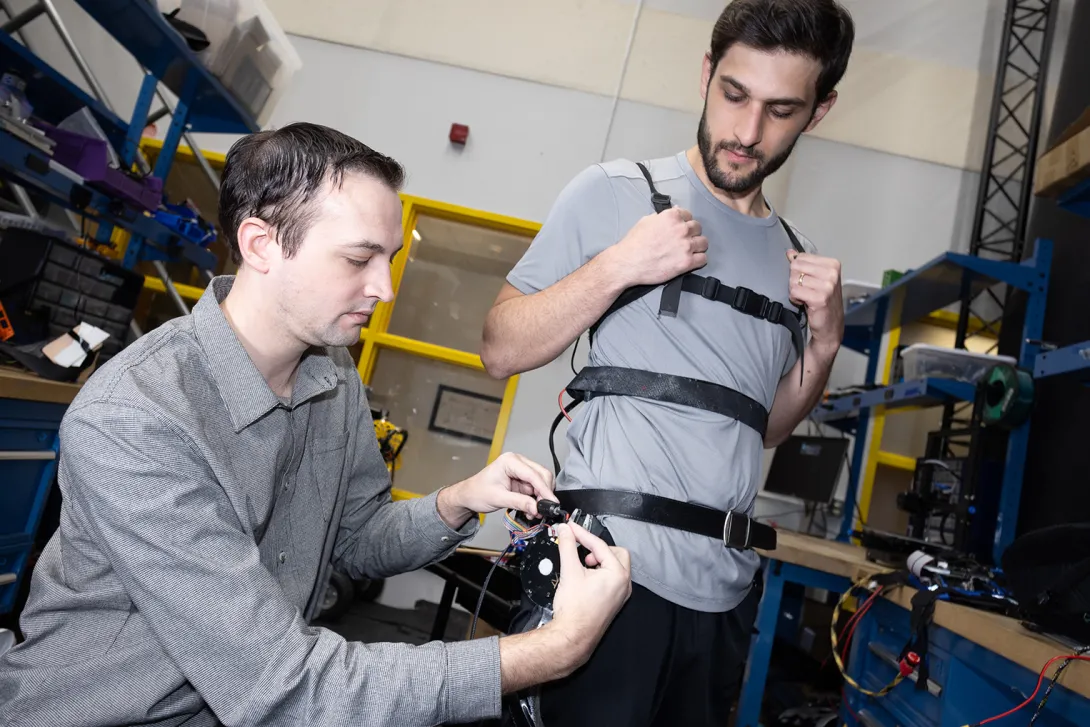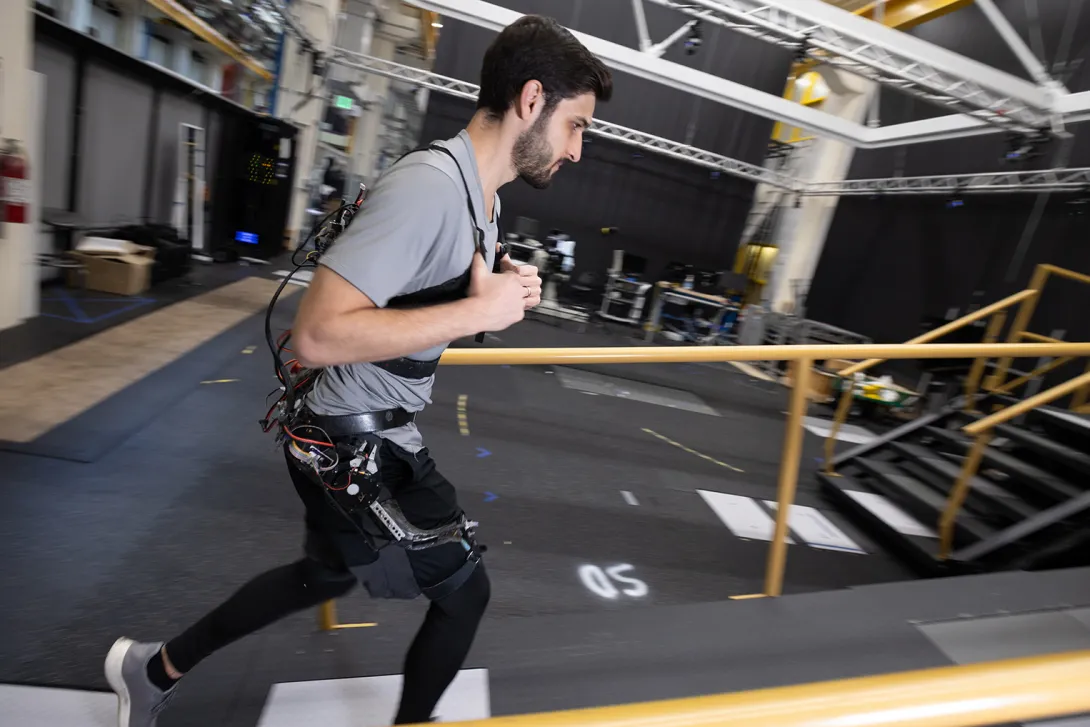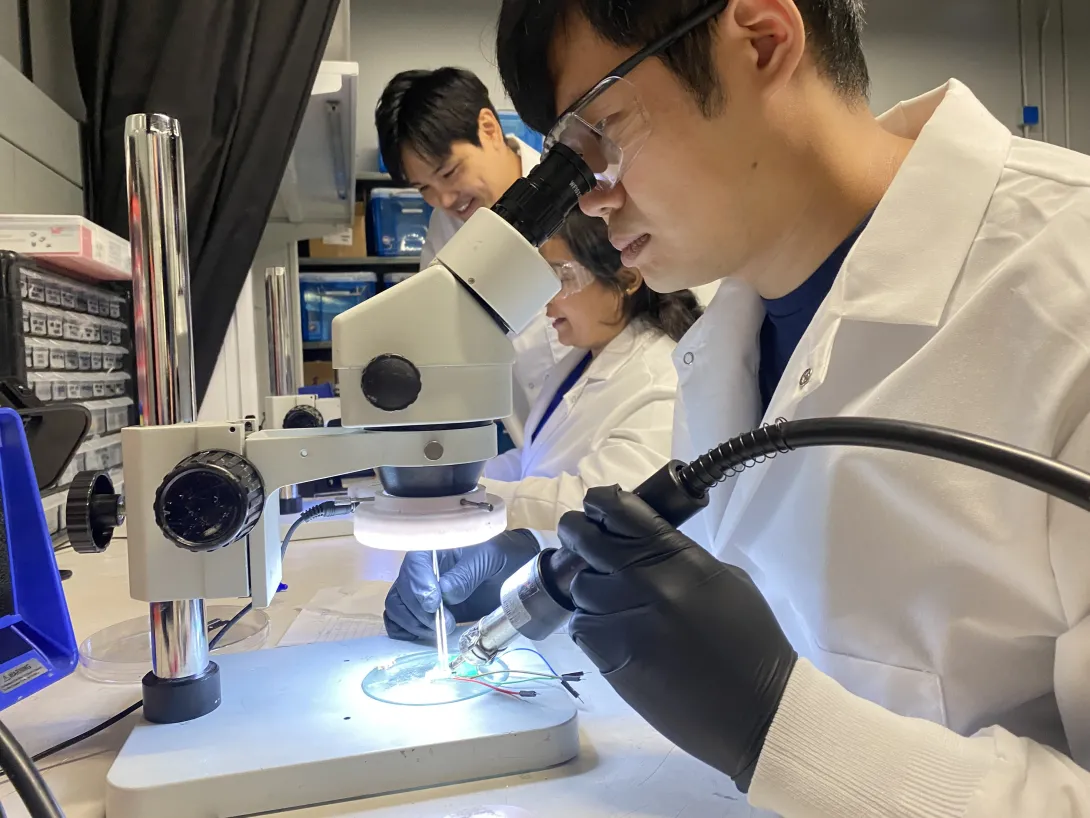May. 02, 2024
Quantum sensors detect the smallest of environmental changes — for example, an atom reacting to a magnetic field. As these sensors “read” the unique behaviors of subatomic particles, they also dramatically improve scientists’ ability to measure and detect changes in our wider environment.
Monitoring these tiny changes results in a wide range of applications — from improving navigation and natural disaster forecasting, to smarter medical imaging and detection of biomarkers of disease, gravitational wave detection, and even better quantum communication for secure data sharing.
Georgia Tech physicists are pioneering new quantum sensing platforms to aid in these efforts. The research team’s latest study, “Sensing Spin Wave Excitations by Spin Defects in Few-Layer Thick Hexagonal Boron Nitride” was published in Science Advances this week.
The research team includes School of Physics Assistant Professors Chunhui (Rita) Du and Hailong Wang (corresponding authors) alongside fellow Georgia Tech researchers Jingcheng Zhou, Mengqi Huang, Faris Al-matouq, Jiu Chang, Dziga Djugba, and Professor Zhigang Jiang and their collaborators.
An ultra-sensitive platform
The new research investigates quantum sensing by leveraging color centers — small defects within crystals (Du’s team uses diamonds and other 2D layered materials) that allow light to be absorbed and emitted, which also give the crystal unique electronic properties.
By embedding these color centers into a material called hexagonal boron nitride (hBN), the team hoped to create an extremely sensitive quantum sensor — a new resource for developing next-generation, transformative sensing devices.
For its part, hBN is particularly attractive for quantum sensing and computing because it could contain defects that can be manipulated with light — also known as "optically active spin qubits."
The quantum spin defects in hBN are also very magnetically sensitive, and allow scientists to “see” or “sense” in more detail than other conventional techniques. In addition, the sheet-like structure of hBN is compatible with ultra-sensitive tools like nanodevices, making it a particularly intriguing resource for investigation.
The team’s research has resulted in a critical breakthrough in sensing spin waves, Du says, explaining that “in this study, we were able to detect spin excitations that were simply unattainable in previous studies.”
Detecting spin waves is a fundamental component of quantum sensing, because these phenomena can travel for long distances, making them an ideal candidate for energy-efficient information control, communication, and processing.
The future of quantum
“For the first time, we experimentally demonstrated two-dimensional van der Waals quantum sensing — using few-layer thick hBN in a real-world environment,” Du explains, underscoring the potential the material holds for precise quantum sensing. “Further research could make it possible to sense electromagnetic features at the atomic scale using color centers in thin layers of hBN.”
Du also emphasizes the collaborative nature of the research, highlighting the diverse skill sets and resources of researchers within Georgia Tech.
“Within the School of Physics, Professor Zhigang Jiang's research group provided the team with high-quality hBN crystals. Jingcheng Zhou, who is a member of both Professor Hailong Wang’s and my research teams, performed the cutting-edge quantum sensing measurements,” she says. “Many incredible students also helped with this project.”
Du is a leading scientist in the field of quantum sensing — this year, she received a new grant from the U.S. Department of Energy, along with a Sloan Research Fellowship for her pioneering work on developing state-of-the-art quantum sensing techniques for quantum information technology applications. The prestigious Sloan award recognizes researchers whose “creativity, innovation, and research accomplishments make them stand out as the next-generation of leaders in the fields.”
This work is supported by the U. S. National Science Foundation (NSF) under award No. DMR-2342569, the Air Force Office of Scientific Research under award No. FA9550-20-1-0319 and its Young Investigator Program under award No. FA9550-21-1-0125, the Office of Naval Research (ONR) under grant No. N00014-23-1-2146, NASA-REVEALS SSERVI (CAN No. NNA17BF68A), and NASA-CLEVER SSERVI (CAN No. 80NSSC23M0229).
News Contact
Written by Selena Langner
Contact: Jess Hunt-Raston
Director of Communications
College of Sciences at Georgia Tech
Apr. 22, 2024
Effective July 1, Eric Vogel will become the executive director of the Institute for Matter and Systems (IMS), Georgia Tech’s newest Interdisciplinary Research Institute (IRI) that will launch on the same date.
As an evolution of the Institute for Materials (IMat) and the Institute for Electronics and Nanotechnology (IEN), IMS aims to enable convergent research at Georgia Tech related to the science, technology, and societal underpinnings of innovative materials and devices. Additionally, IMS seeks to integrate these innovations into systems that enhance human well-being and performance across information and communication, the built environment, and human-centric technologies that improve human health, wellness, and performance.
“Executive Vice President for Research Chaouki Abdallah and I are very excited about the launch of IMS, which positions Georgia Tech for integration of science and technology from atoms to devices, while explicitly drawing in researchers in the social sciences, design, business, and computing,” said Vice President of Interdisciplinary Research Julia Kubanek.
“IMS will ensure relevance across Georgia Tech through its newly configured Internal Advisor and Ambassador Board with representation across all six Colleges and GTRI,” she said. “Additional advisory committees representing IMS employees and facility users will ensure that we don’t sacrifice any of the research excellence for which IEN and IMat are known. With IMS I expect we will be even better positioned to tackle research problems that will have the greatest positive societal impact.”
Vogel will continue in his current position as the executive director of IMat until the launch of IMS. In addition to leading and growing IMat, Vogel is the Hightower Professor of Materials Science and Engineering at Georgia Tech’s School of Materials Science and Engineering, and he served as the IEN deputy director prior to leading IMat.
“It is an honor to be appointed executive director of the Institute for Matter and Systems, and I look forward to collaborating with the talented faculty and staff associated with it,” said Vogel. “This opportunity allows us to leverage the core competencies of IEN and IMat while extending our capabilities beyond nanotechnology and materials science. Together, we will be a hub for interdisciplinary research ranging from advanced materials to complex systems that solve global challenges.”
Georgia Tech’s IRIs facilitate collaboration between researchers and students from its six Colleges, the Georgia Tech Research Institute, national laboratories, and corporate entities to tackle critical topics of strategic significance for the Institute as well as for local, state, national, and international communities. IMS will also house and maintain the state-of-the-art Materials Characterization Facility and one of the largest academic cleanrooms in the nation, which offers a broad range of fabrication capabilities from basic discovery to prototype realization.
Before joining Georgia Tech in 2011, Vogel was an associate professor of materials science and engineering and electrical engineering at the University of Texas at Dallas. During this time, he also served as the associate director of the Texas Analog Center of Excellence and led UT Dallas’s involvement in the Southwest Academy for Nanoelectronics.
Prior to UT Dallas, he led the CMOS and Novel Devices Group and established the Nanofabrication Facility at the National Institute of Standards and Technology. Vogel holds a Ph.D. in electrical engineering from North Carolina State University and a B.S. in electrical engineering from the Pennsylvania State University. His research focuses on the development and fundamental understanding of electronic and nanomaterials and devices.
News Contact
Laurie Haigh
Research Communications
Apr. 19, 2024
Metz, France
Three-dimensional (3D) hetero-integration technology is set to transform the field of electronics. Vertically stacking functional layers, creates novel 2D-3D circuit architectures with high integration density and unprecedented multifunctionality.
Three researchers at Georgia Tech-CNRS IRL 2958, a joint international research laboratory based at Georgia Tech-Europe in Metz, France, were among a team that demonstrated cutting-edge 2D/single-crystalline 3D/2D (2D/C-3D/2D) Integration using a precise layer splitting technique to overcome drawbacks in ferroelectric materials use in electrostatic capacitors.
Abdallah Ougazzaden, professor of Electrical and Computer Engineering at Georgia Tech, and president of Georgia Tech-Europe, Phuong Vuong, Georgia Tech-CNRS IRL 2958 researcher, and Suresh Sundaram, adjunct faculty in Georgia Tech’s School of Electrical and Computer Engineering, are co-authors on an April 19, 2024 research article in the journal, Science, entitled “High energy density in artificial heterostructures through relaxation time modulation.”
Ferroelectric materials used in electrostatic capacitors have unique advantages such as maximum polarization due to their higher electric susceptibilities related to dielectric constants, or permittivity, a measure of a material’s ability to store electrical energy. However, their high remnant polarization, the amount of polarization that remains in the material after the electric field is removed, limits how well they can store and release energy during the discharging process.
In the Science article, researchers demonstrated an innovative approach that sandwiches a single crystalline BTO (C-BTO) layer with 2D materials in the form of a freestanding membrane and effectively suppresses the remnant polarization of ferroelectric materials while maintaining the maximum polarization.
This ultra-thin vertical stacking technology was achieved using three different two-dimensional materials in combination with single crystalline BTO (C-BTO). Hexagonal boron nitride semiconductor was developed in the International Research Laboratory at GT-Europe, while graphene, and Molybdenum disulfide (MoS2) were developed at MIT.
These new 2D material technologies have a special type of bonding called van der Waals forces. On account of this, the layers can be easily separated to create components without needing any chemical etching or cutting processes.
“The 2D hexagonal boron nitride (h-BN) material that we are developing at Georgia Tech-CNRS IRL 2958 on large surfaces using the MOCVD epitaxial growth technique has demonstrated its significant potential in emerging technologies across various domains such as future quantum computers, biotechnology, flexible electronics, sensors, energy, and optogenetics.” said Ougazzaden, head of the h-BN project at Georgia Tech-CNRS IRL 2958,” adding, “We are currently working on some of these applications, and we hope to produce even more results and demonstrate new achievements."
Electrostatic capacitors, with their ability to store and release electrical energy quickly, find a wide range of applications across various fields of electronics and electrical engineering for energy storage, power conditioning etc.
In a similar collaboration, the same research team from Georgia Tech-CNRS IRL 2958 published a paper in December 2023, showing the first demonstration of the monolithic 3D integration of an artificial intelligence (AI) processor using two-dimensional (2D) materials.
This innovative integration approach combined six layers of transistor and memristor networks into a 3D nano-system. By stacking nanoscale materials made from 2D materials using bottom-up technology, the team created a fully integrated AI system.
The monolithic 3D method significantly improved processing efficiency by reducing time, voltage drops, latency, and footprint. In addition to offering a solution for electronic hetero-integration with 2D materials, broke new ground for advanced multifunctional processors and systems for AI applications and complex computing.
The team’s results on vertical hetero-integration were published in the scientific journal, Nature Materials, entitled, "Monolithic 3D Integration of 2D Materials-Based Electronics towards Ultimate Edge Computing Solutions.”
The researchers who contributed to the Science article discovered that when ferroelectric materials are combined in special structures (like 2D/C-3D/2D layers), it affects how much leftover charge a capacitor has and how well it can store energy. These insights will advance designs of high-energy capacitors using these materials. In the future, this could lead to more efficient and powerful energy storage systems.
Apr. 16, 2024
More than 400 people participated in Energy Materials Day on March 27, as researchers and industry leaders came together to discuss and advance energy materials technologies such as solar energy, carbon-neutral fuels, and batteries.
Energy materials are the things — natural, manufactured, or both — that aid the use of energy. They also play a key role in developing cleaner, more efficient energy solutions.
Energy Materials Day was co-hosted by Georgia Tech’s Strategic Energy Institute (SEI), the Institute for Materials (IMat), and the Georgia Tech Advanced Battery Center. The event evolved out of last year’s Georgia Tech Battery Day.
“As an engine of innovation in science and technology, Georgia Tech has incredible opportunities and the responsibility to conduct research to benefit society,” said Chaouki Abdallah, executive vice president for Research at Georgia Tech. “We call this ‘research that matters.’”
Events like Energy Materials Day are part of an ongoing, long-range effort to position Georgia Tech, and Georgia, as a go-to location for modern energy companies. Tech was recently ranked by U.S. News & World Report as the top public university for energy research. Abdallah also outlined why Georgia Tech, with more than 1,000 researchers across campus working in the energy space, is a natural fit for events that foster collaboration between the public and private sectors.
“Right here, right now, we have the opportunity to harness our collective powers, our collective knowledge, our collective resources to become a global engine of innovation,” he said.
Plenary speaker Danielle Merfeld, global chief technology officer at QCells, highlighted opportunities for the current and future clean energy infrastructure in the United States.
"At the heart of our discussions today [are these questions]: What is new technology, and how do you make it ... and make it at scale, in an affordable, accessible, and reliable way?” she said.
"... [The] good news is this country has taken a very deliberate step toward creating the most robust industrial policy we've had in decades. ... This is driving opportunity and creating the foundation for manufacturing. So, [we can] use that industrial base of making and consuming power [and] decarbonize the electric grid by 2035...."
“Events like this are so important to forwarding progress in research and industry,” said Eric Vogel, IMat’s executive director. “It’s important to bring together professionals throughout the industry to keep these lines of communication open.”
The day was divided into three tracks: battery materials and technologies, photovoltaics and the grid, and materials for carbon-neutral fuel production. Attendees were encouraged to listen to talks from all three areas. Each track included academic speakers who shared their research and private-sector speakers who described how technological advancements are affecting the industry.
“With its rich history in energy research, Georgia Tech remains a leader in addressing global energy challenges,” said Tim Lieuwen, executive director of SEI. “The success of Energy Materials Day is encouraging, and I eagerly anticipate continuing these discussions in 2025.”
News Contact
Amelia Neumeister
Research Communications Program Manager
Apr. 02, 2024
Georgia Tech is supporting career growth for its research faculty, who do critical work at the heart of the research enterprise.
The word faculty is often synonymous with tenure-track professors — the individuals who teach courses and run major labs with their surnames in the title. But while groundbreaking discoveries regularly happen at Georgia Tech, the people doing the day-in, day-out research aren’t always visible.
Research faculty are non-tenure track faculty who carry out crucial research in labs, centers, and departments across campus. They are the lifeblood of research enterprises at major universities like Georgia Tech, but their work often occurs behind the scenes.
To support these essential employees, Georgia Tech launched an initiative to recognize and develop research faculty, who comprise 60% of the nearly 4,400 total faculty currently employed at the Institute. It is part of the second phase of Research Next, the strategic plan for Georgia Tech’s research enterprise.
Maribeth Coleman, interim assistant vice provost for Research Faculty, and Michelle Rinehart, vice provost for Faculty, were appointed as co-chairs of a Research Next implementation team tasked with finding ways to recognize, support, and retain research faculty. Building on years of effort and collaboration with campus partners, the group took on several projects to improve the research faculty experience and environment at Georgia Tech.
“Research faculty are critical members of the Georgia Tech community, and their contributions to our billion-dollar research enterprise and the state’s economic development cannot be overstated,” Rinehart said. “We wanted to understand what it’s like for research faculty as they come on board at Georgia Tech, what the hiring process is like, and how we as an Institute can more effectively mentor and develop research faculty in terms of advancing in their careers.”
At the outset, the implementation team identified and examined several facets of the research faculty experience. They reviewed policies in the faculty handbook, giving special attention to existing guidance for promotion and career growth for research faculty.
Promotion guidelines are generally clear for tenure-track faculty. Research faculty, on the other hand, are often not actively encouraged to seek promotion, and may not even know that promotion is an option, according to Rinehart and Coleman. One issue is that funding for research faculty often comes from external research dollars. At least nine months of a tenure-track faculty member’s salary, however, comes from the state budget.
“When you’re constantly having to bring in all of your own salary, as research faculty do, it can be a stressful experience,” Coleman said. “It can also mean you’re more isolated, because you’re focused on bringing in those research dollars that will help you keep your position. But we want research faculty to know that we want them to build their careers here.”
To address these issues, the team developed reference materials and workshops for research faculty seeking promotion. The workshops are offered on a regular basis, and resources and recordings are available on the Georgia Tech faculty website. The team also created educational materials for promotion committees, often composed of tenure-track faculty who are unfamiliar with the research faculty experience.
“We saw a need for better consistency across campus with regards to guidance for research faculty promotion committees,” Rinehart said. “Tenure-track faculty need guidance on not just how to properly hire research faculty, but also in how to mentor and retain them.”
According to Coleman and Rinehart, the implementation team’s most significant achievement was the launch of a research faculty mentoring network. The mentoring network connects junior research faculty mentees with senior research faculty mentors who have grown their careers at Georgia Tech.
“When new tenure-track faculty arrive, they are usually assigned a mentor within their School or department, but that method doesn’t generally work for research faculty,” Coleman said. “There may not be a large research faculty community in their unit, and research faculty roles and responsibilities vary significantly from person to person. For this reason, the mentoring network is meant to foster cross-pollination and build community across units.”
The mentoring network is a collaboration with MentorTech, a program run by Georgia Tech Professional Education. The program is ongoing, and enrollment is always open.
To foster inclusivity and belonging, the team established an orientation program for research faculty, modeled after the tenure-track faculty orientation. The Provost’s Office hosted the inaugural research faculty orientation in Fall 2023. Because research faculty are hired throughout the year, the team decided the orientation should take place semiannually. The second orientation took place on March 13.
In addition to the workshops, mentor network, and orientations, the implementation team also launched a program to welcome research faculty in a personal way. When a new research faculty member is hired, another more senior research faculty member is assigned to welcome them in person, provide them with important information for getting oriented to campus, tell them about relevant professional opportunities, and give them Georgia Tech-branded swag.
“All of this work is about recognizing that research faculty are a tremendously valuable part of our community,” Rinehart said. “They also really enhance our reputation internationally.”
According to Coleman, research faculty can sometimes be viewed as disposable, because of their support from grants that may be limited in time and scope. But she believes that line of thinking is a disservice to both the individual and the Institute.
“It’s important that we recognize the value of research faculty, nurture them, and retain them long term,” she said. “We need to make it possible for people to spend their careers here, as I have, and help make sure research faculty positions at Georgia Tech can be both viable and fulfilling long-term careers.”
To read more about Georgia Tech's strategic research initiatives, visit the Research Next website.
Mar. 26, 2024
Jud Ready, a principal research engineer at the Georgia Tech Research Institute (GTRI), has been selected to join the National Academy of Inventors’ (NAI) 2024 Class of Senior Members – a group of 124 academic inventors from NAI’s Member Institutions who have made significant contributions to innovation and technology.
Holding a dual appointment as Deputy Director of Innovation Initiatives for Georgia Tech’s Institute for Materials, one of Tech’s 10 Interdisciplinary Research Institutes (IRI) focused on advancing materials research and innovation, and with over two decades of experience as an adjunct professor in Tech’s School of Materials Science & Engineering, Ready has established himself as a leader in materials science and engineering.
Read the full story
News Contact
Michelle Gowdy
(Interim) Director of Communications, GTRi
Mar. 21, 2024
Georgia Tech opened the 11th annual Atlanta Science Festival (ASF) with record attendance for Science and Engineering Day. Despite the drizzly weather, about 4,000 people of all ages from throughout metro Atlanta — more than double the number of attendees in 2023 — visited campus on Saturday, March 9, 2024, for the space-themed event. They explored more than 45 exhibitions and hands-on activities related to art, robotics, nanotechnology, chemical and systems engineering, and biology, as well as other STEAM areas.
Visitors began their investigations at “Earth” (the Kendeda Building for Innovative Sustainable Design), where they picked up a galactic passport specially designed to guide them from building to building — each designated with the name of a planet — and the demonstrations housed within.
At “Mars” (Marcus Nanotechnology Building), attendees measured their height in nanometers, experimented with fruit batteries, and took a window-tour of the largest cleanroom in the Southeast, where semiconductors are developed. Inside “Venus” (Parker H. Petit Biotech Building), budding scientists examined bioluminescent bacteria under a microscope and made Play-Doh models of the human brain. When visiting “Saturn” (Ford Environmental Sciences and Technology Building), visitors studied density by making DIY lava lamps and inspected human brain specimens the way a pathologist would.
“Getting to hold a human brain was cool,” said a 12-year-old participant from Alpharetta. “And I also liked comparing it to the brains of a pig and a mouse.”
Other activities included math games and puzzles, the opportunity to build an artificial hand and a gallery display of research-inspired artwork. Georgia Tech faculty, students, and staff hosted all the demonstrations and served as volunteers who helped Science and Engineering Day guests navigate campus and the demonstration sites.
For many participants, the undoubted highlight was the chance to hear a presentation by former NASA astronaut and Georgia Tech alumnus Shane Kimbrough, MS OR 1998. Kimbrough spent 388 days in space over three missions and served as commander of the International Space Station (ISS) in 2016. He captivated the standing-room-only crowd with photos and descriptions of his time living and working aboard the ISS and answered questions from the kids in the audience.
“It’s really exciting to see all the activities around campus today … we’re inspiring the next generation of scientists and explorers for our country,” Kimbrough said afterward.
The event was a resounding success for Georgia Tech and the Atlanta Science Fair.
Lauren Overton-Kirk, who organized the event for the Institute, said, "Georgia Tech Science and Engineering Day 2024 was so wonderful to share with the community. What started years ago as a day for young scientific exploration became an all-ages, space-themed scientific spectacular. You could feel the passion for learning fill the campus in a way only Georgia Tech could do.”
Both the Georgia Tech and the Atlanta Science Festival teams are looking forward to next year’s Science and Engineering Day.
“As one of the founding organizations of the Atlanta Science Festival, Georgia Tech has been deeply invested in sharing the Institute’s innovations with the community,” said Meisa Salaita, ASF co-director. “And that investment was deeply evident on March 9th as they opened their doors to kick off the 11th annual Science Festival. Their students and faculty came out with enthusiasm to showcase science to the public. We couldn't be more thrilled with this partnership — and the many ways Tech has helped us show our community that Atlanta is a science city.”
News Contact
Shelley Wunder-Smith, Institute Communications
Mar. 20, 2024
Robotic exoskeletons designed to help humans with walking or physically demanding work have been the stuff of sci-fi lore for decades. Remember Ellen Ripley in that Power Loader in Alien? Or the crazy mobile platform George McFly wore in 2015 in Back to the Future, Part II because he threw his back out?
Researchers are working on real-life robotic assistance that could protect workers from painful injuries and help stroke patients regain their mobility. So far, they have required extensive calibration and context-specific tuning, which keeps them largely limited to research labs.
Mechanical engineers at Georgia Tech may be on the verge of changing that, allowing exoskeleton technology to be deployed in homes, workplaces, and more.
A team of researchers in Aaron Young’s lab have developed a universal approach to controlling robotic exoskeletons that requires no training, no calibration, and no adjustments to complicated algorithms. Instead, users can don the “exo” and go.
Their system uses a kind of artificial intelligence called deep learning to autonomously adjust how the exoskeleton provides assistance, and they’ve shown it works seamlessly to support walking, standing, and climbing stairs or ramps. They described their “unified control framework” March 20 in Science Robotics.
“The goal was not just to provide control across different activities, but to create a single unified system. You don't have to press buttons to switch between modes or have some classifier algorithm that tries to predict that you're climbing stairs or walking,” said Young, associate professor in the George W. Woodruff School of Mechanical Engineering.
News Contact
Joshua Stewart
College of Engineering
Mar. 18, 2024
Researchers with Georgia Tech and Emory University are field testing a new device that could help protect people who work outside from heat related injury. It’s a skin patch you can wear while working that sends detailed information to a smartphone or other device about important health markers like skin hydration and body temperature. The device takes different measurements than health wearables on the market currently and will be paired with an artificial intelligence program to predict health hazards. The team is calling the device BioPatch, and it’s being put to the test with landscaping crews. Researchers hope use of the device can guide better decisions about working in the heat.
The project involves collaboration between principal investigators Vicki Hertzberg from Emory University, W. Hong Yeo from Georgia Tech, and Li Xiong from Emory University. Their expertise spans statistics, mechanical and biomedical engineering, and computer science, respectively. Roxana Chicas of the Emory School of Nursing and Jeff Sands of the Emory School of Medicine, along with members of the Farmworker Association of Florida, are also part of the team. This video shows the device and data collection during a key component of testing during the summer.
Mar. 13, 2024
Muhannad Bakir has been named director of the Institute for Electronics and Nanotechnology’s 3D Systems Packaging Research Center (PRC).
"We’re thrilled to have Professor Bakir joining us as the new director,” said Michael Filler, IEN’s interim executive director. “His wealth of experience and pioneering work in advanced packaging make him an excellent fit to lead the PRC into an exciting new era of innovation and technological impact.”
Originating as a National Science Foundation Engineering Research Center in 1993, the PRC is a national leader in the advanced packaging of microelectronics. Advanced packaging in microelectronics refers to innovative techniques for merging and interconnecting multiple components within a single electronic entity. This enables more powerful, efficient, and versatile microelectronic systems, driving innovation across various industries. The Center conducts research and education in all aspects of electronics packaging, including design, materials, process, assembly, thermal management, and system integration. Its work is driven by a wide range of applications, such as high-performance computing, artificial intelligence, automotive systems, wireless communications, and space exploration.
“I am honored for the opportunity to lead the PRC and look forward to working with the campus community and our industry, government, and academic partners on a research agenda that tackles the multifaceted challenges in advanced packaging and heterogeneous integration,” said Bakir.
As director, Bakir will guide the PRC into the future of advanced packaging through his vision and expertise. He is responsible for ensuring that the PRC's world-class facilities support the emerging needs of advanced packaging of microelectronics and supports members of the campus community who uses these facilities.
“We are excited to lead the science and engineering that culminates in system level prototyping and demonstrators for AI, mm-wave, photonic systems, and beyond,” he said.
Bakir, who also serves as the Dan Fielder Professor in the School of Electrical and Computer Engineering and leads the Integrated 3D Systems Group, brings a wealth of experience to his new role as PRC director. He and his research group have received more than 30 paper and presentation awards including seven from the IEEE Electronic Components and Technology Conference, four from the IEEE International Interconnect Technology Conference, and one from the IEEE Custom Integrated Circuits Conference. His group was also awarded the 2014 and 2017 Best Papers of the IEEE Transactions on Components Packaging and Manufacturing Technology.
Bakir is the recipient of the 2013 Intel Early Career Faculty Honor Award, 2012 DARPA Young Faculty Award, 2011 IEEE CPMT Society Outstanding Young Engineer Award, and was an Invited Participant in the 2012 National Academy of Engineering Frontiers of Engineering Symposium. He is the co-recipient of the 2018 IEEE Electronics Packaging Society Exceptional Technical Achievement Award “for contributions to 2.5D and 3D IC heterogeneous integration, with a focus on interconnect technologies.” He is also the co-recipient of the 2018 McKnight Foundation Technological Innovations in Neuroscience Awards. In 2020, Bakir received the Georgia Tech Outstanding Doctoral Thesis Advisor Award.
He serves as a senior area editor for the IEEE Transactions on Components, Packaging and Manufacturing Technology and was previously an Editor for IEEE Transactions on Electron Devices. He has also served as a distinguished lecturer for IEEE EPS.
News Contact
Amelia Neumeister
Research Communications Program Manager
Pagination
- Previous page
- 10 Page 10
- Next page

